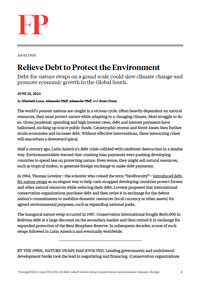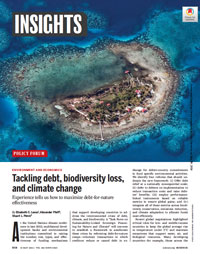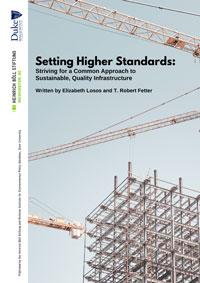Publications
A Roadmap for Foreign Assistance to Support Quality Infrastructure: Findings and Recommendations from the US Government Infrastructure Assistance Review
The US Government has committed to help build a pipeline of quality infrastructure projects in low- and middle-income countries that contribute to inclusive, sustainable growth, and that attract private capital. This review focuses on the earliest stages of infrastructure project development and the enabling conditions within a country that contribute to the development of a pipeline of quality infrastructure projects. The authors offer recommendations on how to prioritize US foreign assistance in these early stages to improve the likelihood of drawing subsequent private-sector financing.
America Prepared: A New Approach—Building a Nation Prepared for Extreme Weather
Federal policy and programs can play a critical role in helping communities—especially those with limited resources—ensure both security and economic vitality in the face of increasing threats from natural hazards. But to get there, the federal government needs a more coordinated approach to empower state and local governments, as well as local institutions and private-sector partners that are working hand in hand with homeowners, businesses, and local and Tribal governments. In this brief, the authors recommend four critical proactive actions the federal government could take to effectively and cost-efficiently prepare the nation for these extreme events and reduce their catastrophic impacts.
Relieve Debt to Protect the Environment
Debt-for-nature swaps on a grand scale could slow climate change and promote economic growth in the Global South.
Tackling Debt, Biodiversity Loss, and Climate Change
Debt distress, biodiversity loss and climate change are interconnected crises for developing countries. A task force of multilateral development banks and environmental institutions is convening a task force to establish a framework to ameliorate these crises by reforming debt-for-nature swaps. The authors of this Policy Forum identify four reforms that should underpin the new framework.
Adapting to the Impacts of Climate Change: A Comparative Study of Governance Processes in Australia, China, and the United States
In 2023, UN climate proceedings (COP 28) made clear that challenges of adapting to climate impacts are now a priority comparable to the focus on mitigation (greenhouse gas reduction). Floods, wildfires, drought, and heat are causing great damage in the United States and other highly developed countries which, on paper, were prepared. The report explains that in contrast to mitigation (greenhouse gas reduction) and further now longstanding environmental governance approaches, adaptation may call for transformation of core governance structures, tools and resources.
Building Bridges? PGII versus BRI
The recently launched Partnership for Global Infrastructure and Investment (PGII)—a G-7 initiative to mobilize $600 billion in loans and grants for sustainable, quality infrastructure projects in developing and emerging economies—aims to provide much-needed investment toward achieving global development goals.
Developing Key Performance Indicators for Climate Change Adaptation and Resilience Planning
This document from the Resilience Roadmap project recommends a common approach to developing key performance indicators (KPIs) for climate change adaptation and resilience planning, drawing upon current science and tools referenced throughout. The work is particularly aimed to support climate adaptation and resilience planning by US federal agencies and thus presents principally US national-level data and online resources. The approach is broadly applicable across agencies, sectors, and systems and can also be applied by state or local planners and adaptation/resilience practitioners.
Building a Common Approach: Global Infrastructure Standards
Well-planned, -designed, and -built infrastructure projects are critically needed to improve economic productivity, transition to a low-carbon economy, mitigate environmental risks, and promote human rights and social inclusion. Investors lack a reliable, widely recognized global standard for identifying “bankable” infrastructure projects with low environmental, social, and governance risks; high debt transparency; and reliable economic returns. A new report compares three sets of standards under development and offers recommendations to reduce confusion and advance a common approach.
Setting Higher Standards: Striving for a Common Approach to Sustainable, Quality Infrastructure
A barrier to the development of high-quality, sustainable infrastructure is the lack of a global standard for identifying projects with low environmental, social, and governance risks; high debt transparency; and reliable economic returns. This policy brief focuses on two new initiatives being developed to meet this need—Blue Dot Network and FAST-Infra—and offers recommendations to reduce competition between them and promote the broadscale advancement of quality, sustainable infrastructure.
Infrastructure Investment Must Incorporate Nature’s Lessons in a Rapidly Changing World
The authors of this commentary in One Earth suggest that infrastructure must become more resilient as the global climate changes and also more affordable in the economic and political context of a post-COVID world, and that we can solve this dual challenge and drive global infrastructure investment into a more sustainable direction by taking our cues from Nature.










